I'thousand sharing my comprehensive guide with you hither on how to build drawers for cabinets and furniture in this mail service!
.
I know I'g in the minority here, but I love to build drawers. It never gets old and I love calculation them to the furniture I build whenever I can. Just, I know for many, drawer making seems intimidating and frustrating.

I'm detailing EVERYTHING—from how to calculate your drawer size, to what holes on the slides to put your screws in. EVERYTHING. I'm showing you EXACTLY how I do information technology every unmarried fourth dimension. So if you're prepare to starting time making drawers, let's become to it. Exist warned, this is a long postal service, simply it'southward Full of info.
.
Every bit a general note, I will be talking virtually ball begetting, side mount drawer slides only in this post. That'southward the simply kind I use in my projects. I've found all others to be extremely frustrating. PS, if you similar the desk and dresser I show in this mail service, exist sure to check those posts out hither: DIY Desk and DIY Dresser.

Also, I make all my drawers using ¾" plywood for the box and ¼" plywood for the bottom. A whole lot of making, installing and building drawers is making sure things are lined up and square. I like to use plywood to build my drawers because so I don't have to worry about twisted or warped boards causing me issues with alignment.

Besides, it looks SUPER Clean and because plywood doesn't move nigh every bit much as solid forest with seasonal changes, it's less likely to cause any stress pulling or pushing on slides, etc.
.
The following is the exact process I use to make, measure, and install drawer boxes. It'south not necessarily correct or incorrect…information technology'south but what works for me. If yous'd like a printable version, y'all can grab i here:
Spring to:
- Step 1: Determine Drawer Front Heights
- Stride 2: Mount Drawer Slides
- Step 3: Build Drawer Boxes
- Step 4: Install the Drawer Box Into Slides
- Step 5: Attach Drawer Fronts
Stride 1: Make up one's mind Drawer Front Heights
Types of Drawer Fronts
Before we can figure out drawer front sizes, we need to embrace the different scenarios for drawer fronts. First, you lot need to determine whether your drawer fronts volition be inset or overlay. (Meet this post for data on inset vs. overlay) Then, y'all need to determine whether you have framed or a frameless drawers.
.
Here are a few examples:
The top drawer of this desk-bound is inset with a frame (observe information technology is surrounded on all sides by a frame). Discover the drawers are inset considering they ready within the forepart of the cabinet. The lesser drawers are inset without a frame (observe that the cabinet DOES have a face frame, but the private drawers are not individually framed).

And then we have full overlay drawers that are not framed in this instance. Notice the drawers hang OVER the sides of the cabinet and are not individually framed.

How to Determine Drawer Front end Size?
Part of this involves math, but part of it involves personal preference. I'll show you two examples to help give you an idea how to summate sizes.
.
Measurements for Inset Framed Drawers
Inset framed drawers are by far the easiest to figure. Simply measure the opening of the frame and decrease ¼" from both height and width to find your drawer front size. Basically, the rule of pollex is assuasive ⅛" space around all sides between the drawer front end and the frame.

Measurements for Frameless Drawers
All the same, if the drawers are not individually framed you take options. And options complicate things.
.
Let's look at this kitchen chiffonier equally an example. I want three drawers, so I demand iii drawer fronts. I want the two bottom ones equal size and the top one smaller. I also want these drawer fronts full overlay (come across this post for details on overlay/inset options).
.
Since these are total overlay, my drawer fronts will comprehend the entire forepart of the cabinet EXCEPT ⅛" on all sides (see this mail service for details). In that location should too be ⅛" gap Between the drawer fronts likewise.
.
Then my chiffonier height is 31", and I subtract the ⅛" superlative gap, ⅛" lesser gap, and two ⅛" gaps between drawer fronts and I take thirty ½" total in drawer forepart coverage. If I want 2 fronts to be 12" tall, then 30 ½" – 12" – 12" = vi ½" left for the top drawer front.
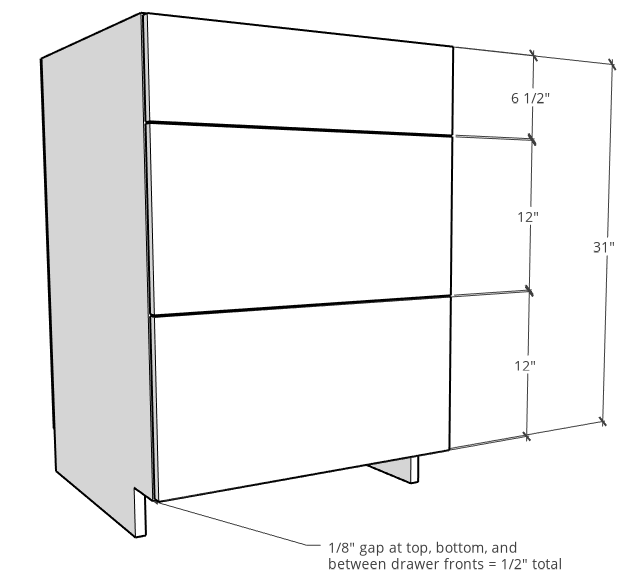
If you are doing inset drawer fronts, the idea is exactly the same except all your drawers would accept to fit Inside the opening and not comprehend the sides…like on the bottom of this dresser shown here.

If I wanted those drawers to all be equal, I would have thirty ½" and separate by three to get all the fronts need to be ten ⅙"—so I'd probably round down to 10 ⅛" since that'due south the closest number on my record mensurate haha.
Footstep 2: Mountain Drawer Slides
Now that I have my drawer front end sizes figured out, I tin can effigy out where to mount my slides. I use ball bearing slides for all my furniture and cabinets. They are easy to use and easy to accommodate. So that's what I'll be showing in this postal service. FYI y'all tin can purchase these from Home Depot, or online from Amazon, Rockler, tons of other retailers.
.
Brawl bearing slides come up in many sizes—usually in ii" increments, then, 10", 12", 14" and so on usually up to about 24" long. You tin purchase these with or without soft close mechanisms. You lot can choose whatever size slide you desire as long as it's the same length or shorter than the depth of whatsoever y'all are installing it into.
.
If your drawer front end will be inset into your cabinet, yous too have to take into consideration that that volition push button your slide back the thickness of your drawer front. So in that instance, if I take a cabinet 22" deep and I have a ¾" thick inset drawer front, I can't utilize a 22" slide anymore. I have to go with a twenty" or shorter slide.
How and Where Practise I Install the Drawer Slides?
I go a lot of questions about jigs to mount the slides. I don't use any. When at all possible, I turn my cabinets or piece of furniture on its side to install my slides instead of doing information technology while the slice is standing. It'south much easier to measure and install that way without anything moving while driving the screws.

I lay the chiffonier over, measure, mark, so use a square to describe a line at that mark square to the front end of the cabinet. And then, I line the slide up with the marker and screw in place.
.
I always beginning at the bottom and work my way up. I mount the get-go slide all the mode at the bottom of the cabinet. OR if it's got a frame, I mount the slide so that the bottom is flush with the bottom opening of the frame.
.
Since I already know my drawer front superlative, I can effigy out where to mount the slides pretty easy. Let'due south look again at this cabinet example. I've greyed out the drawer fronts to requite you a visual here.
.
My bottom drawer front end is 12". To brand things easy and give me enough of jerk room, I measure up from the bottom of the cabinet about 1" higher than that drawer front end—and so xiii". That's where I mount the next slide.
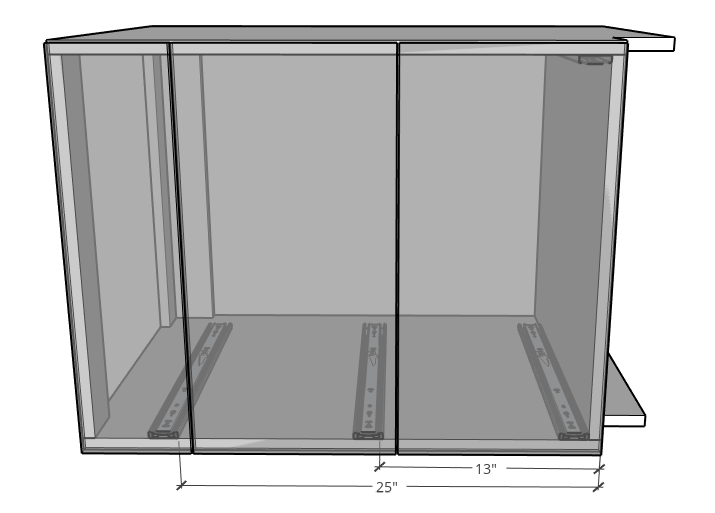
Then I do the aforementioned for the next slide above information technology, merely add together the two fronts below it plus an extra inch—so 12" + 12" +i" = 25". As long equally you clear the drawer forepart below it, it's not critical where you place your slide equally long every bit it'southward the aforementioned on both sides of the chiffonier.
.
If this was for inset drawers, the same applies, just mensurate from the Within of the opening vs the Outside of the cabinet.
Inset vs. Overlay Mounting
If y'all are using overlay drawer fronts, install your slides flush with the front of your chiffonier.
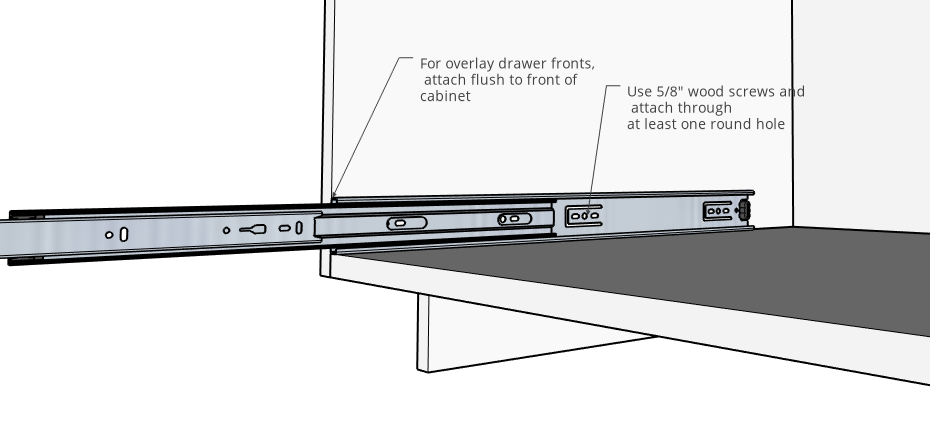
Simply, if you are using inset drawer fronts, install them the thickness of your front INSET from the front of your chiffonier. Typically, your front will be ¾" thick, so install it ¾" from the front edge of the cabinet.
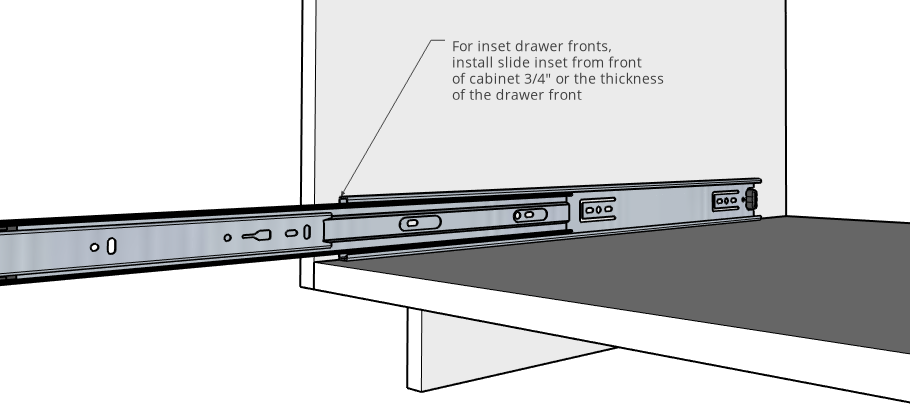
Typically, these brawl begetting drawer slides have horizontally slotted holes on the slice that mounts to the cabinet and vertically slotted holes that mount to the drawer box.
.
This offers yous the ability to adjust the drawer box in both directions as needed. I've never used the horizontal slots to adjust, then when I install these into the cabinet, I use the round holes to keep it held in identify.
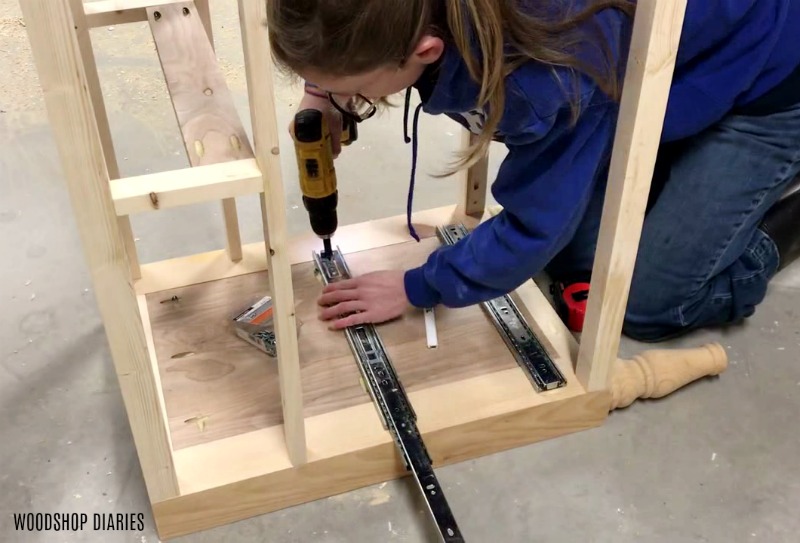
Only extend the slide, and use ⅝" woods screws to attach the slides into the cabinet in at least iii places.
Do I need spacer blocks?
Everything prior to this assumed frameless cabinets or that the inside of the cabinet was flush.
.
But, if a cabinet or article of furniture has a face frame that covers a portion of the inside of the cabinet like shown below on this storage desyard, you'll need to install a spacer block then that y'all tin can mount the drawer slide affluent with the opening in the frame so it can slide in and out.
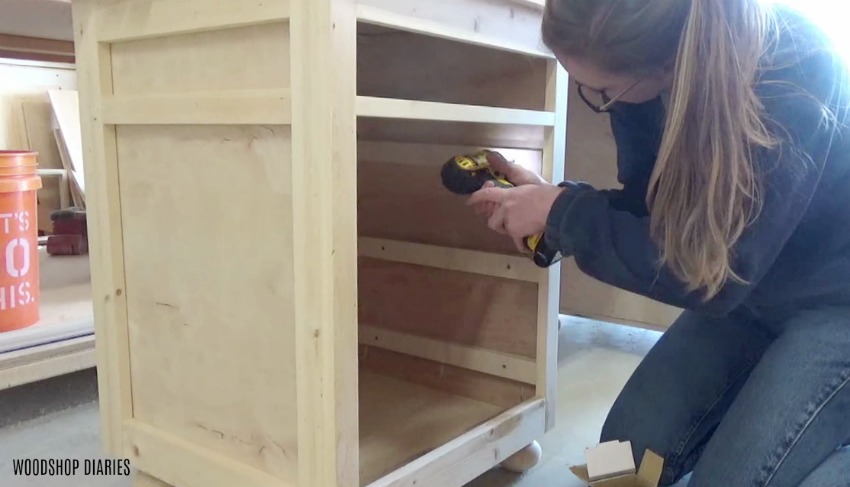
You'll mount the spacer blocks at the measurements discussed above, so mount the slides on top of them similar shown.
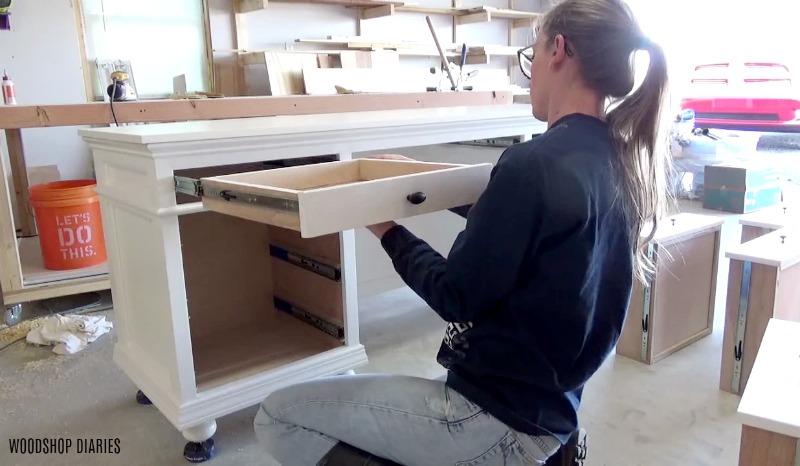
Step 3: Build Drawer Boxes
And then now that the slides are in place, now information technology's fourth dimension to actually build drawers.
Drawer Box Tiptop
Again, just similar with the drawer forepart sizes, there are two main options that y'all may meet. You either accept a frame effectually the drawer or you don't. In this example with this desk, notice that the bottom cabinet drawers don't take frames merely the superlative ones exercise.

For Framed Drawers: If my drawers take frames, I brand sure that the superlative of my drawer box is at least 1"shorter than the elevation of my opening to make certain it'southward got plenty of room to open and shut.
.
For Unframed Drawers: If my drawers don't accept frames, I make them about 2-iii" shorter than my drawer front. This isn't a "rule," it'south only what I've found to work well for me.
Drawer Box Length & Widths
In order to figure the lengths to cut all the pieces to brand a drawer, you only need two measurements.
.
You demand the length of your slides (ex. If you're using 16" slides, the length is 16"…pretty straightforward), and the width of the opening in which you program to put your drawer. That gives you the LENGTHS to cut your pieces.
.
Frameless Cabinets
So, let's take this instance again. This is a frameless kitchen cabinet that I'm putting three drawers into. I'm using 22" drawer slides, and the width of the opening is X (remember X from algebra course??).
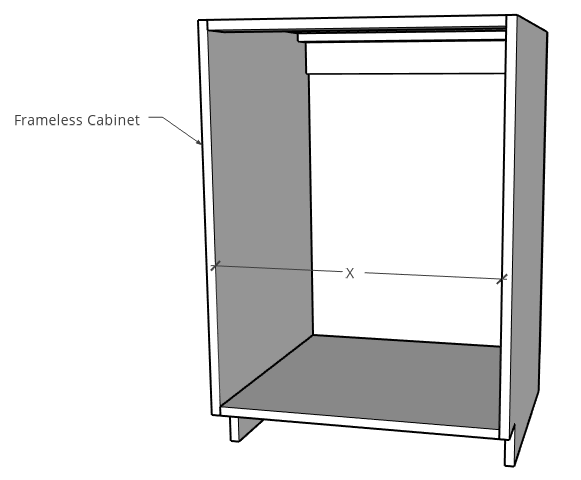
My overall drawer box width should be 1" LESS than my opening—this allows room for the drawer slides.
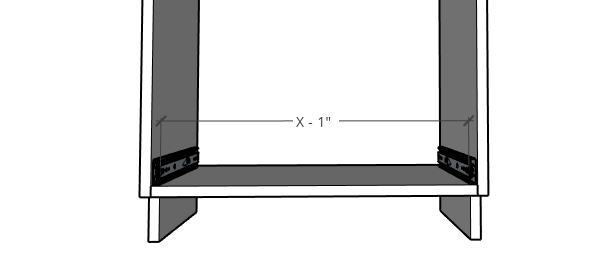
Now, the drawer pieces should be cut every bit follows. The sides are ¾" plywood and the bottom is ¼" plywood. The ¼" plywood goes into dadoes cut into the drawers like shown once it's assembled with pocket holes. I'll show that in detail afterward.
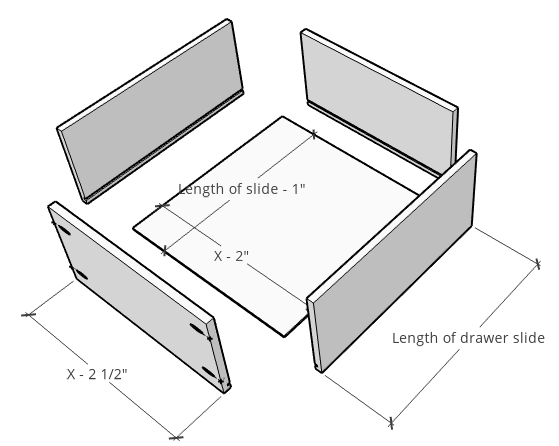
Confront Frame Cabinets
I mentioned adding spacer blocks before into cabinets or article of furniture with face frames. This aforementioned thing applies in the case when you have spacer blocks for your slides, you but need to make sure you measure between the spacer blocks instead of the inside of the cabinet.
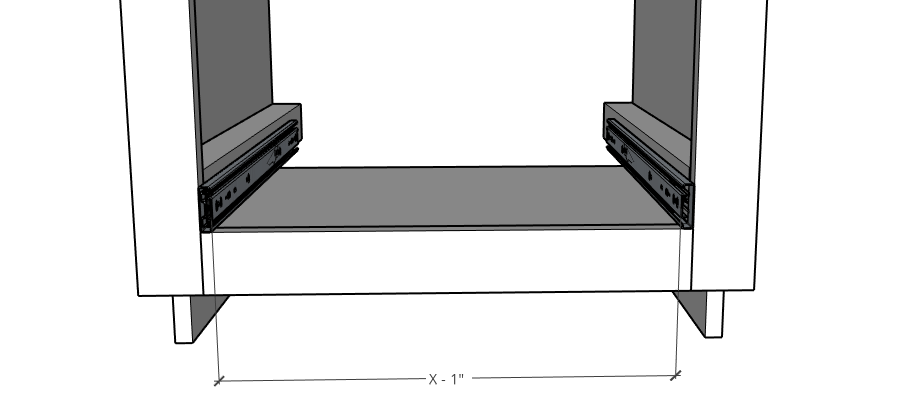
How to Build Drawersouthward
I assemble my drawers using ¼" plywood in dadoes on the drawer box sides. If you don't desire to cut dadoes, you can too, just glue and staple ¼" plywood into the lesser of the drawer box, Nonetheless, you need to keep in mind that that will add together ¼" to the drawer box top, and then you may need to adjust appropriately.
.
I establish the dado method to exist clean looking and potent, then I prefer that. I adjust the height of my table saw blade ¼" and cutting this dado ½" from the lesser side of the drawer box pieces.
.
You tin can make multiple passes with a regular saw bract on the table saw to get the ¼" thickness, or use a ¼" dado bract and make one pass or use a router and ¼" straight chip.
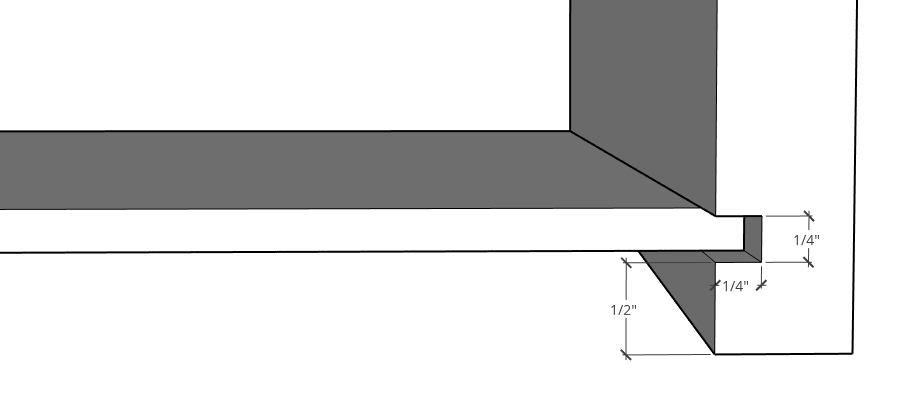
I assemble the side pieces using ¾" pocket holes and ane ¼" wood screws like shown. You tin cheque out whatsoever of my YouTube video tutorials (like this desk-bound or this dresser) where I build something with a drawer to see the process. Once I have three pieces together, I slide the ¼" plywood slice in place and attach the last piece.
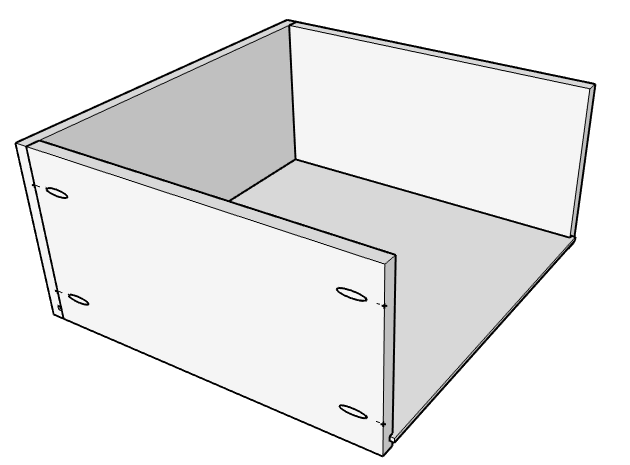
You can utilize a corner clench or square to hold pieces square when assembling them. Merely, the all-time way to assistance ensure the drawer is square is to make sure the ¼" plywood bottom is foursquare earlier putting it in. It should be a pretty tight fit and should hold the pieces foursquare if information technology is foursquare, too.
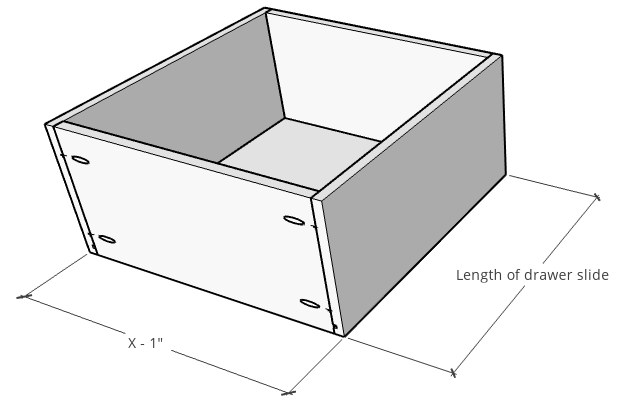
Step four: Install the Drawer Box Into Slides
There are plenty of ways to install the drawer boxes, only this is quick and works well. I e'er starting time at the bottom and install the lesser drawer beginning. I identify ¼" plywood scraps underneath the drawer box and slightly extend the drawer box and the slides on both sides.
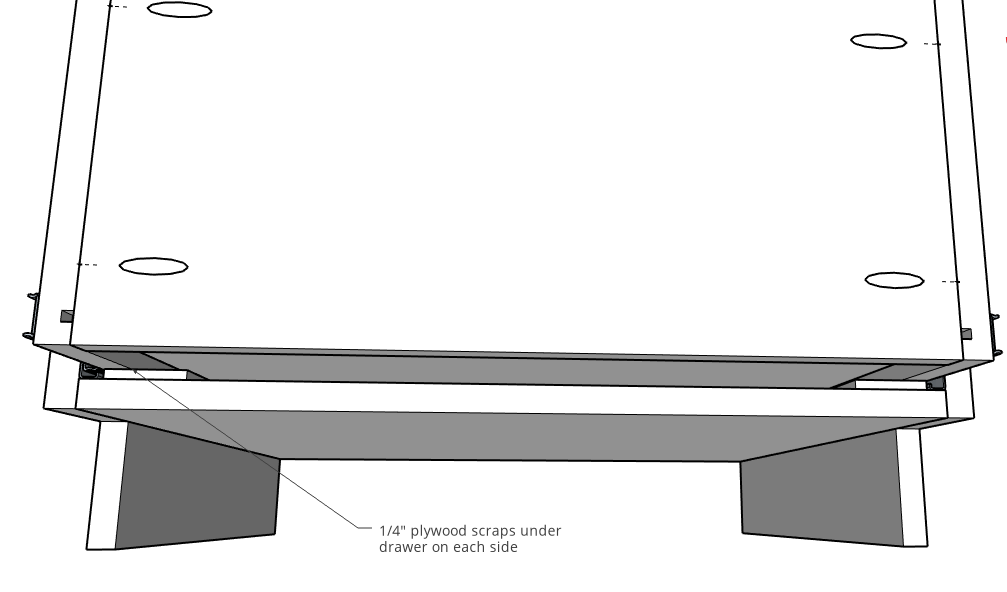
I extend the slide and drawer box then that the front edge of the slide is FLUSH forth the forepart border of the drawer box and put ane ⅝" wood spiral on each side in a vertical slotted hole.
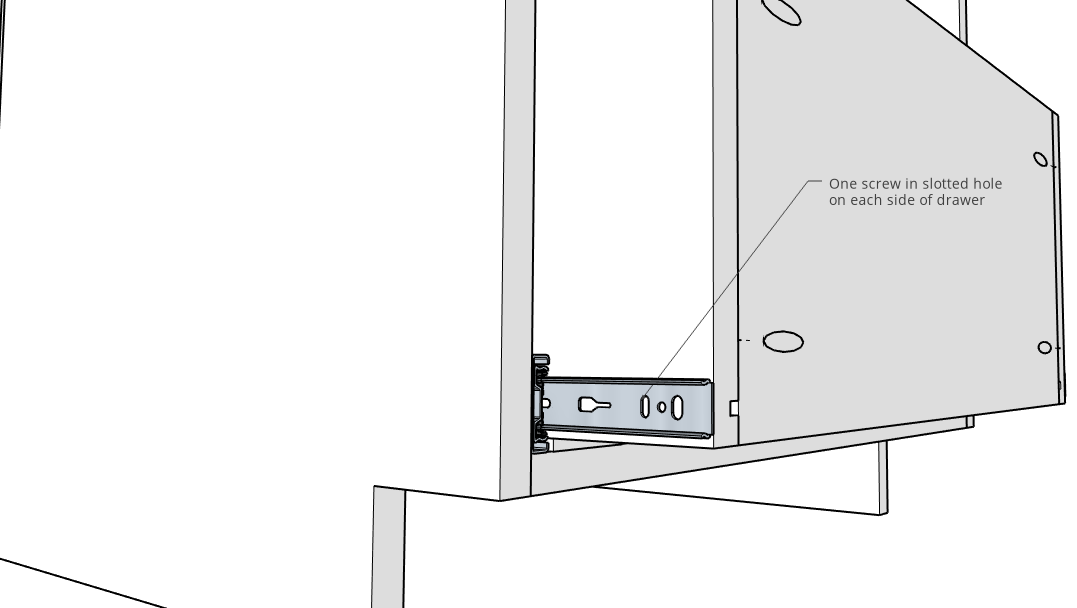
And then, keeping the drawer pushed down on the ¼" plywood scraps, I extend the drawer and add some other spiral on each side into a round hole.
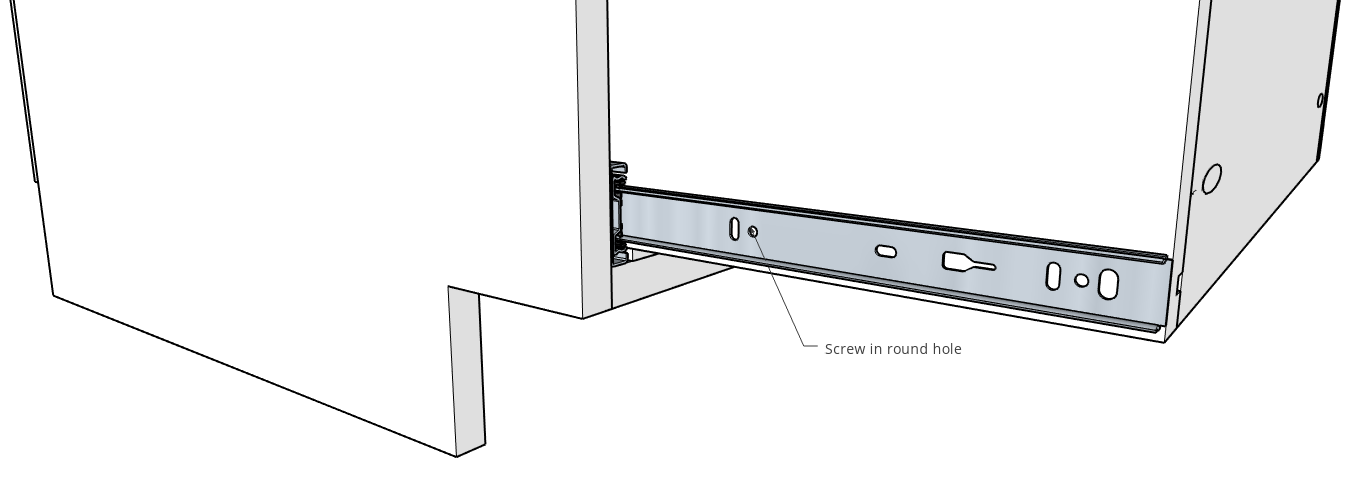
Then, I remove the drawer from the slide and add some other screw onto the dorsum of the slide. To remove the drawer, extend it fully and there will be two tabs on each slide. One volition push up and ane will button down. Simultaneously push these tabs and pull the drawer straight out.
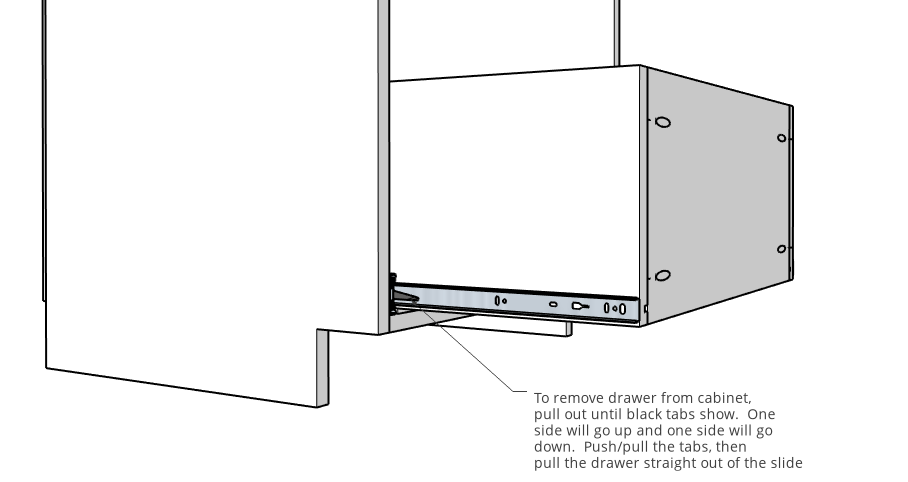
Then add a screw into the stop either in a circular or slotted hole.
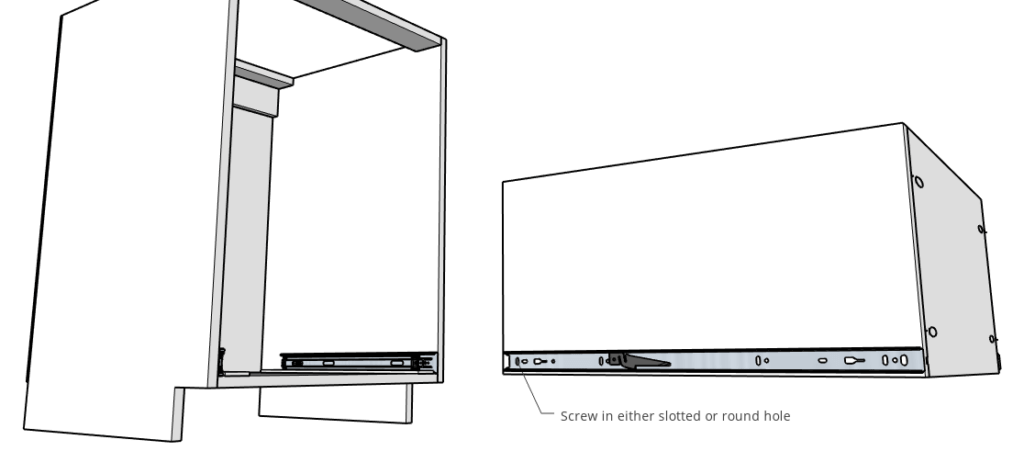
And so, slide the drawer back in identify and adjust as needed using the screws in the vertically slotted holes. Usually it won't demand whatever adjustments, but if it does, that's why the spiral holes are slotted—just loosen the screw, adapt, then tighten again.
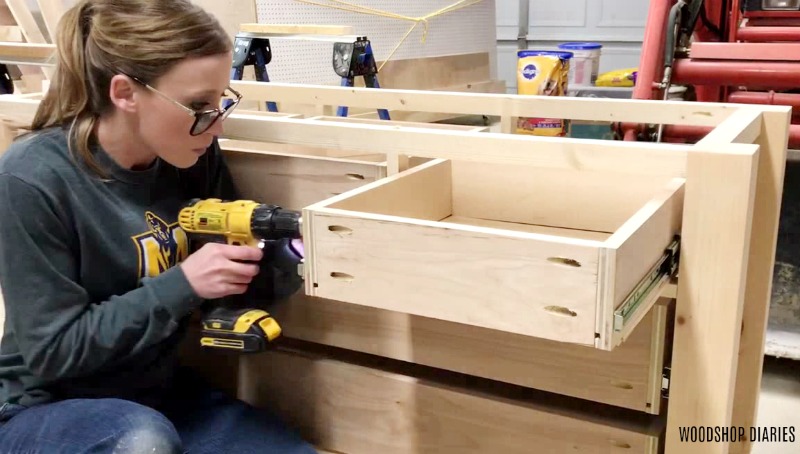
To add the adjacent drawer, I utilise scrap forest blocks stacked on height of the box beneath and follow this same procedure. I stack the spacer blocks until the bottom of the drawer is higher than where the drawer front below information technology volition exist–basically the drawer box just has to clear the drawer front below information technology.
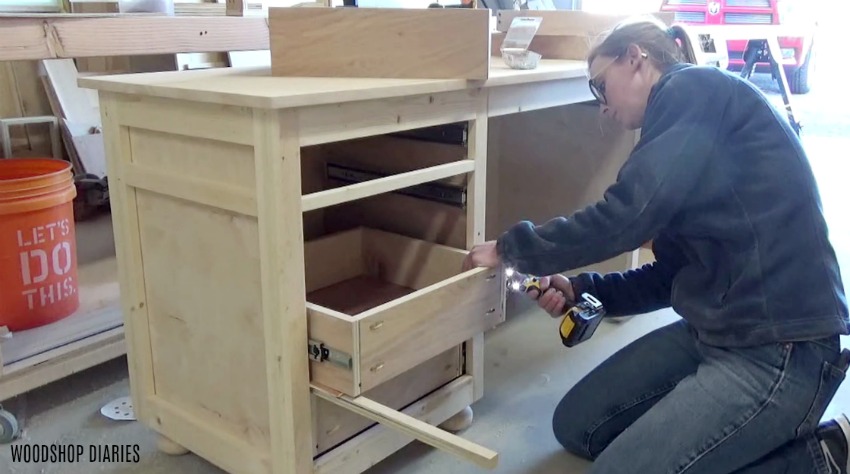
Step v: Attach Drawer Fronts
In that location are a lot of methods for centering and attaching drawer fronts. But, I don't utilize any of them (I know…I'm weird).
.
I've institute the easiest way to adhere drawer fronts is to lay the piece on it's back, and set up the fronts in identify letting gravity hold them where you desire them and so you lot tin can become them centered.
.
Still, if that's not feasible, the next easiest mode is to go out the top of the piece off so you tin can access the inside of the drawers like shown below.
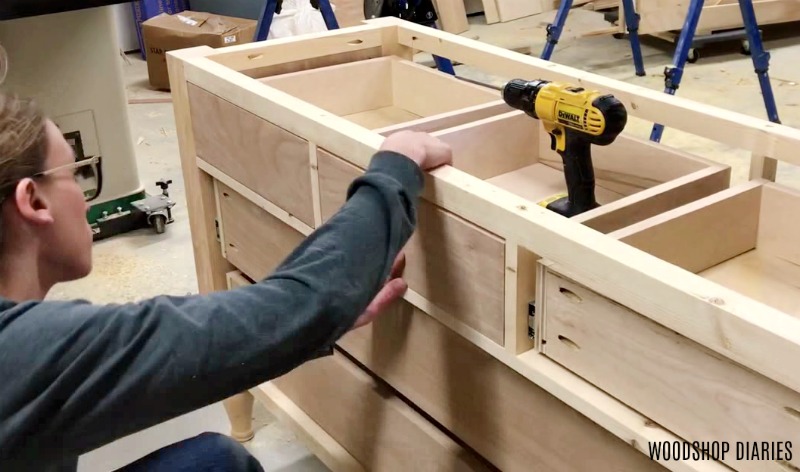
I hold my drawer fronts on, and eyeball the gaps around the edges trying to get them as even equally possible–it should exist near ⅛″ on all sides.
.
If I'thousand painting the piece, I'll brad smash the drawers in place, then utilise a couple of one ¼″ wood screws to securely attach the fronts from the inside of the drawer box. I can putty over the smash holes and no 1 will know.
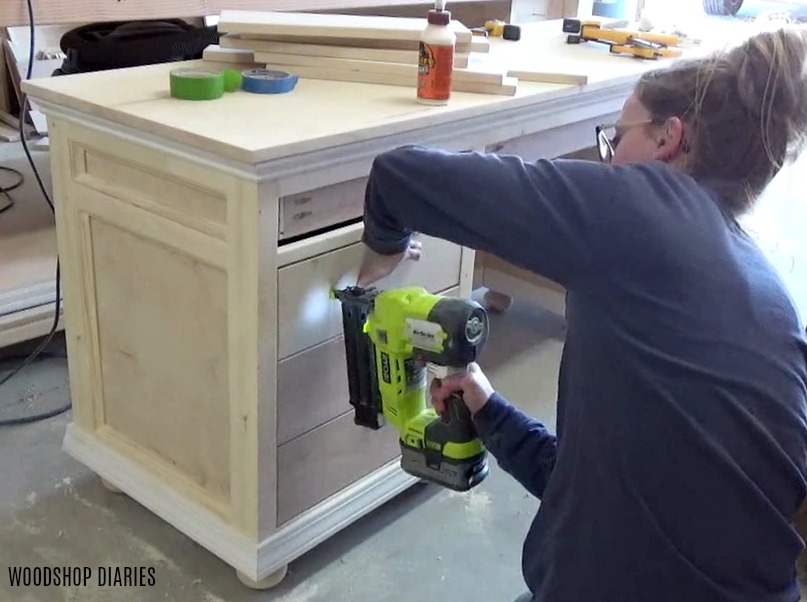
However, if I'm not painting, I avoid the brad nails and find a way to either agree the front in identify or clamp information technology in place while I screw it from the inside. This is why it'due south best to leave the meridian off when possible until after the drawers are finished.
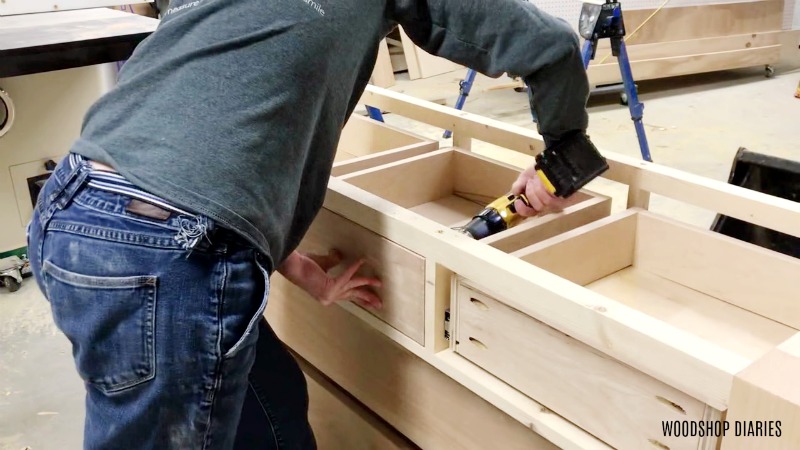
And that's how to measure for, install, and build drawers. I've tried to cram everything I've learned from experience in four years into one behemothic blog mail service tutorial. Whew…that'southward a lot.
.
I'll be 100% honest with you lot, though…this isn't a scientific discipline. Your measurements don't have to be exactly what I showed you. In some of my images, y'all'll even observe that I used to place my slides higher than I practice now. And that worked fine! This post is meant to be a guide, but not the rule book 🙂
.
The best manner to get comfortable with drawers is to try them!! Literally everything I've told you in this post, I learned on my own just by doing it. And so I hope it's been helpful, only now yous've got to USE information technology and get comfortable with it. You lot can exercise this…I promise!
.
So if you enjoyed this post and want to save it for later, be certain to pin it!
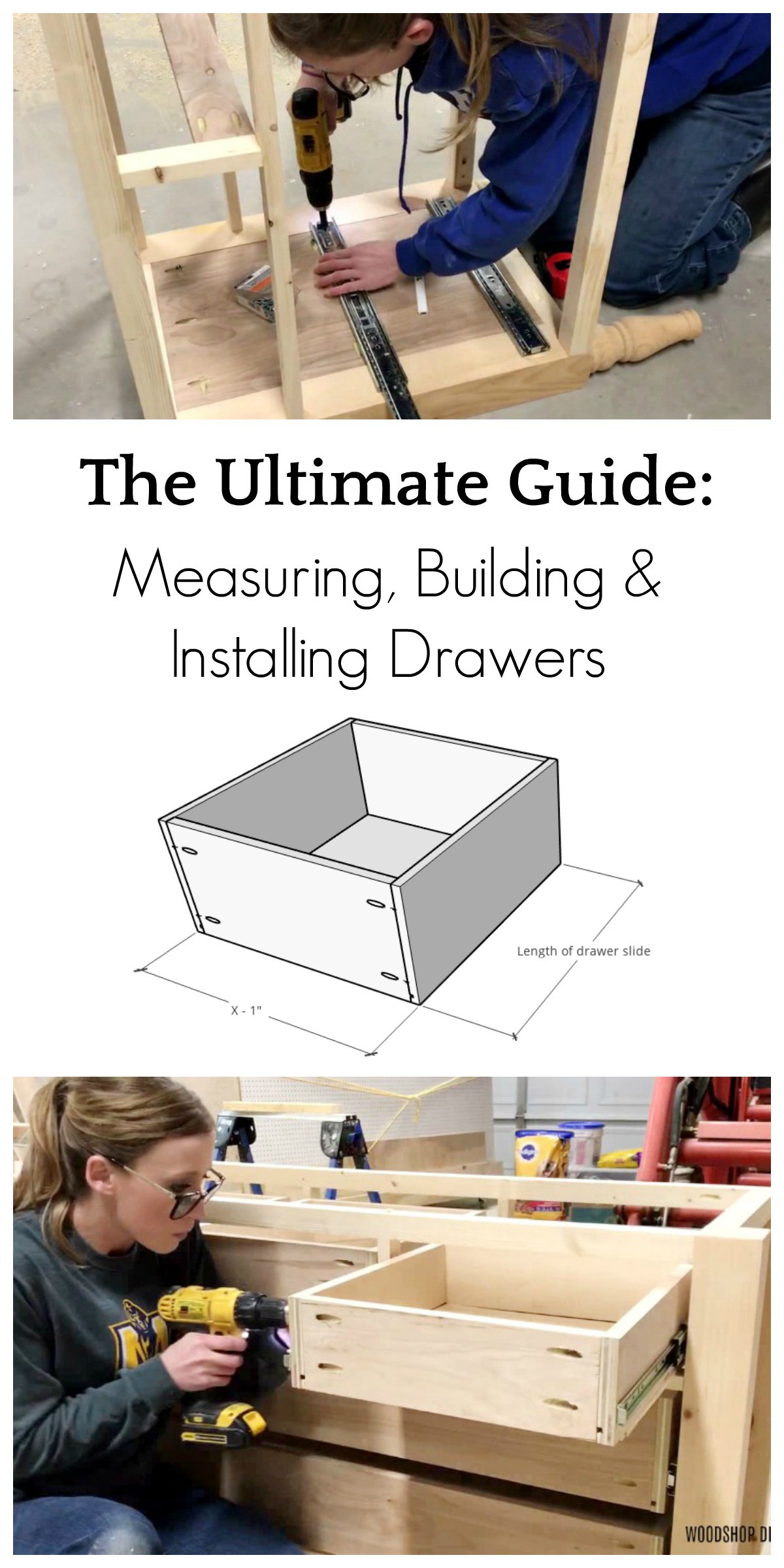
Until next time, friends, happy building 🙂

Source: https://www.woodshopdiaries.com/theres-no-wrong-way-to-make-a-drawer/


Komentar
Posting Komentar